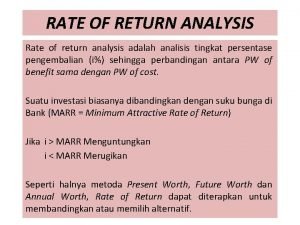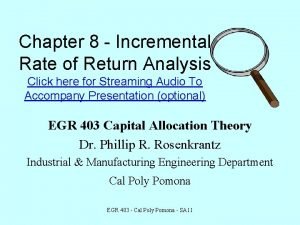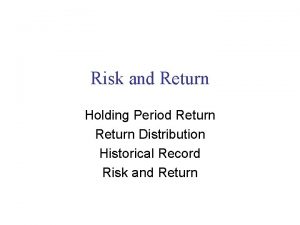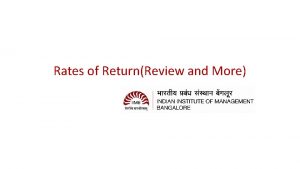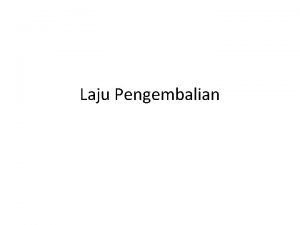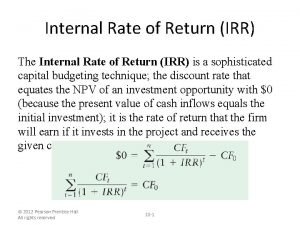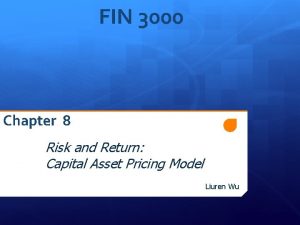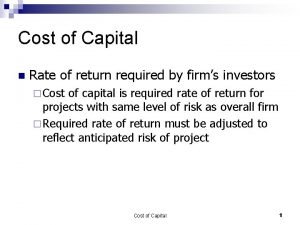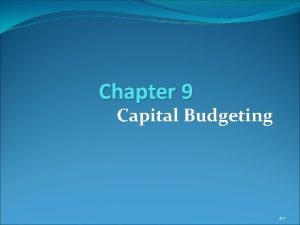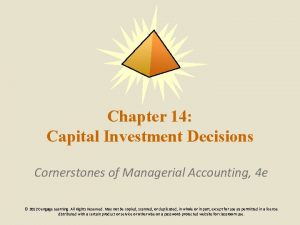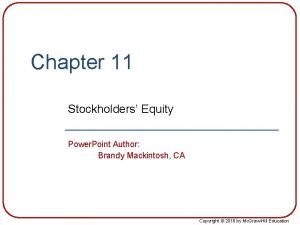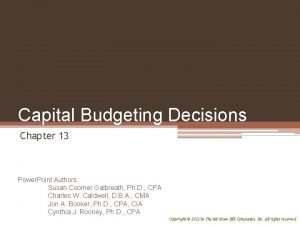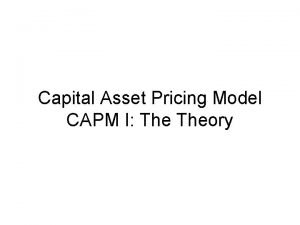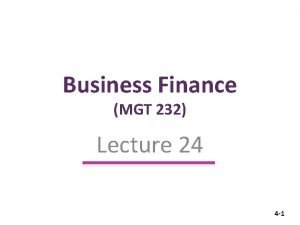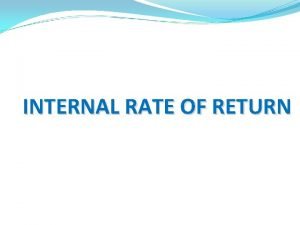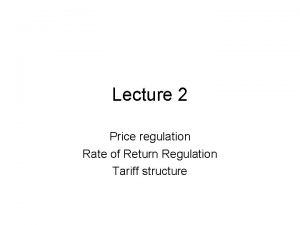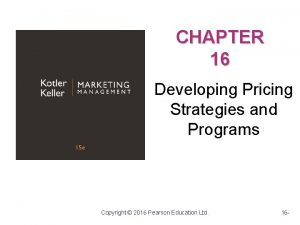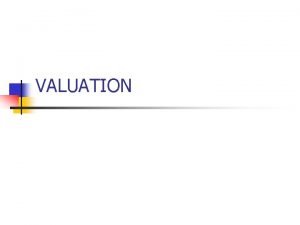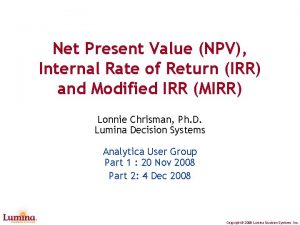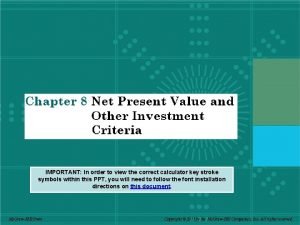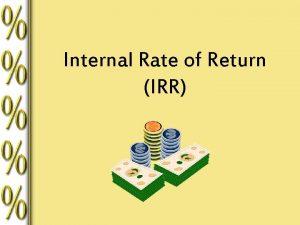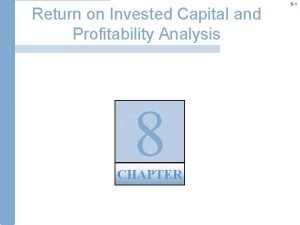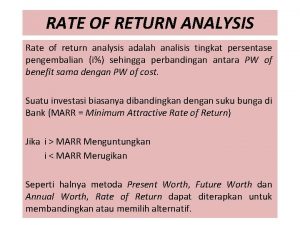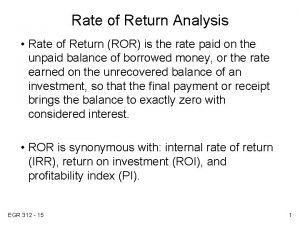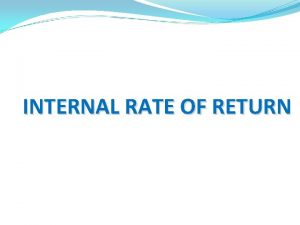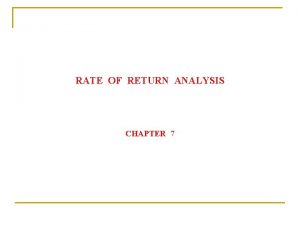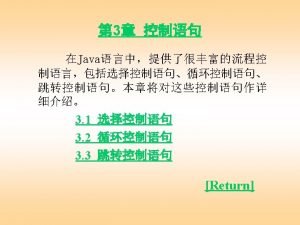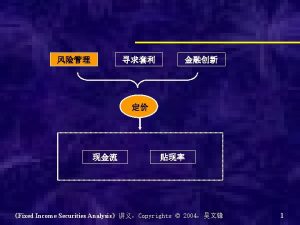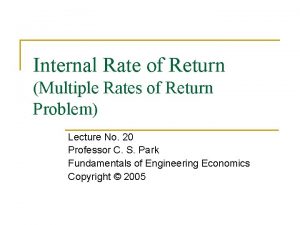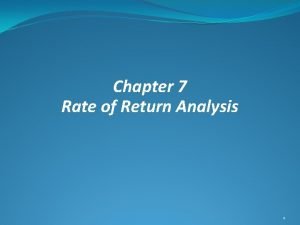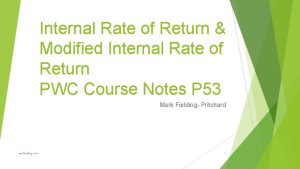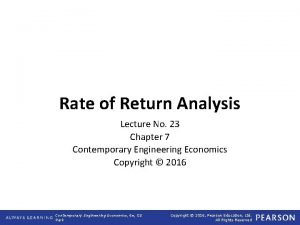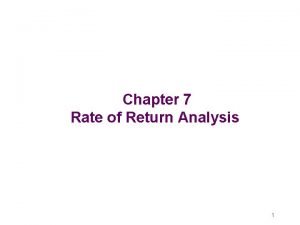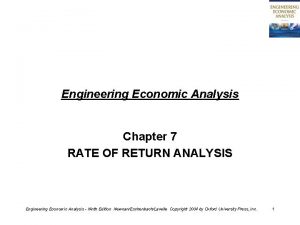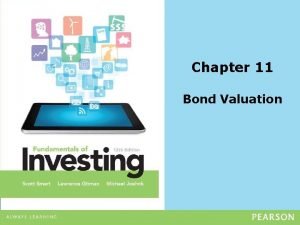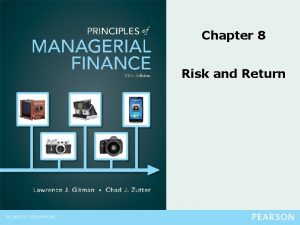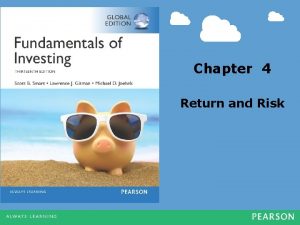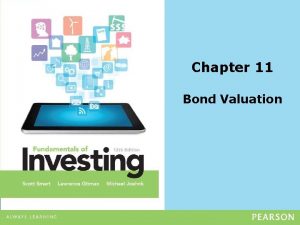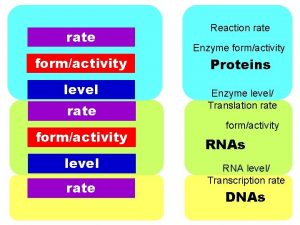Chapter 7 Rate of Return Analysis q Rate






























- Slides: 30

Chapter 7 Rate of Return Analysis q Rate of Return q Methods for Finding ROR q Internal Rate of Return (IRR) Criterion q Incremental Analysis q Mutually Exclusive Alternatives

Rate of Return Definition A relative percentage method which measures the annual rate of return as a percentage of investment over the life of a project.

Example: Meaning of Rate of Return In 1970, when Wal-Mart Stores, Inc. went public, an investment of 100 shares cost $1, 650. That investment would have been worth $12, 283, 904 on January 31, 2002. What is the rate of return on that investment?

Solution: $12, 283, 904 0 32 $1, 650 Given: P = $1, 650 F = $12, 283, 904 N = 32 Find i: $12, 283, 904 = $1, 650 (1 + i )32 Rate of Return i = 32. 13%

Suppose that you invested that amount ($1, 650) in a savings account at 6% per year. Then, you could have only $10, 648 on January, 2002. What is the meaning of this 6% interest here? This is your opportunity cost if putting money in savings account was the best you can do at that time!

So, in 1970, as long as you earn more than 6% interest in another investment, you will take that investment. Therefore, that 6% is viewed as a minimum attractive rate of return (or required rate of return). So, you can apply the following decision rule, to see if the proposed investment is a good one. ROR (32. 13%) > MARR(6%)

Return on Investment Definition 1: Rate of return (ROR) is defined as the interest rate earned on the unpaid balance of an installment loan. Example: A bank lends $10, 000 and receives annual payment of $4, 021 over 3 years. The bank is said to earn a return of 10% on its loan of $10, 000.

Loan Balance Calculation: A = $10, 000 (A/P, 10%, 3) = $4, 021 Year 0 1 2 3 Unpaid balance at beg. of year -$10, 000 -$6, 979 -$3, 656 Return on unpaid balance (10%) -$1, 000 -$698 -$366 Payment received Unpaid balance at the end of year +$4, 021 -$10, 000 -$6, 979 -$3, 656 0 A return of 10% on the amount still outstanding at the beginning of each year

Rate of Return: Definition 2: Rate of return (ROR) is the break-even interest rate, i*, which equates the present worth of a project’s cash outflows to the present worth of its cash inflows. Mathematical Relation:

Return on Invested Capital Definition 3: Return on invested capital is defined as the interest rate earned on the unrecovered project balance of an investment project. It is commonly known as internal rate of return (IRR). Example: A company invests $10, 000 in a computer and results in equivalent annual labor savings of $4, 021 over 3 years. The company is said to earn a return of 10% on its investment of $10, 000.

Project Balance Calculation: 0 1 2 3 Beginning project balance -$10, 000 -$6, 979 -$3, 656 Return on invested capital -$1, 000 -$697 -$365 -$10, 000 +$4, 021 Ending project -$10, 000 balance -$6, 979 -$3, 656 0 Payment received The firm earns a 10% rate of return on funds that remain internally invested in the project. Since the return is internal to the project, we call it internal rate of return.

Methods for Finding Rate of Return n Types of Investment (cash flow) Classification q q Simple Investment Non-simple Investment n Once we identified the type of investment cash flow, there are several ways available to determine its rate of return. n Computational Methods q q q Direct Solution Method Trial-and-Error Method Computer Solution Method

Investment Classification Simple Investment n Definition: Initial cash flows are negative, and only one sign change occurs in the net cash flows series. n Example: -$100, 250, $300 (-, +, +) n ROR: A unique ROR n If the initial flows are positive and one sign change occurs referred to simple-borrowing. Non-simple Investment n Definition: Initial cash flows are negative, but more than one sign changes in the remaining cash flow series. n Example: -$100, 300, -$120 (-, +, -) n ROR: A possibility of multiple RORs 13

Period (N) Project A Project B Project C 0 -$1, 000 +$1, 000 1 -500 3, 900 -450 2 800 -5, 030 -450 3 1, 500 2, 145 -450 4 2, 000 Project A is a simple investment. Project B is a non-simple investment. Project C is a simple borrowing.

Computational Methods n Direct Solution Log Quadratic Trial & Error Method Project A Project B Project C Computer Solution Method Project D 0 -$1, 000 -$2, 000 -$75, 000 -$10, 000 1 0 1, 300 24, 400 20, 000 2 0 1, 500 27, 340 20, 000 3 0 55, 760 25, 000 4 1, 500

Example 7. 2 Project A Direct Solution Methods Project B

Trial and Error Method – Project C n n Step 1: Guess an interest rate, say, i = 15% Step 2: Compute PW(i) at the guessed i value. PW (15%) = $3, 553 n Step 3: If PW(i) > 0, then increase i. If PW(i)< 0, then decrease i. PW(18%) = -$749 n Step 4: If you bracket the solution, you use a linear interpolation to approximate the solution 3, 553 0 -749 15% i 18%

Basic Decision Rule: If ROR > MARR, Accept This rule does not work for a situation where an investment has multiple rates of return

Comparing Mutually Exclusive Alternatives Based on IRR Issue: Can we rank the mutually exclusive projects by the magnitude of its IRR? n A 1 A 2 0 -$1, 000 -$5, 000 1 $2, 000 $7, 000 IRR 100% > 40% $818 < $1, 364 PW (10%)

Who Got More Pay Raise? Bill 10% Hillary 5%

Can’t Compare without Knowing Their Base Salaries Bill Hillary Base Salary $50, 000 $200, 000 Pay Raise (%) 10% 5% Pay Raise ($) $5, 000 $10, 000 For the same reason, we can’t compare mutually exclusive projects based on the magnitude of its IRR. We need to know the size of investment and its timing of when to occur.

Incremental Investment n Project A 1 Project A 2 Incremental Investment (A 2 – A 1) 0 1 -$1, 000 $2, 000 -$5, 000 $7, 000 -$4, 000 $5, 000 ROR PW(10%) 100% $818 40% $1, 364 25% $546 Ø Assuming a MARR of 10%, you can always earn that rate from other investment source, i. e. , $4, 400 at the end of one year for $4, 000 investment. Ø By investing the additional $4, 000 in A 2, you would make additional $5, 000, which is equivalent to earning at the rate of 25%. Therefore, the incremental investment in A 2 is justified.

Incremental Analysis (Procedure) Step 1: Step 2: Step 3: Compute the cash flow for the difference between the projects (A, B) by subtracting the cash flow of the lower investment cost project (A) from that of the higher investment cost project (B). Compute the IRR on this incremental investment (IRRB-A ). Accept the investment B if and only if IRR B-A > MARR NOTE: Make sure that both IRRA and IRRB are greater than MARR.

Example 7. 7 - Incremental Rate of Return n 0 1 2 3 IRR B 1 B 2 -$3, 000 -$12, 000 1, 350 4, 200 1, 800 6, 225 1, 500 6, 330 25% 17. 43% B 2 - B 1 -$9, 000 2, 850 4, 425 4, 830 15% Given MARR = 10%, which project is a better choice? Since IRRB 2 -B 1=15% > 10%, and also IRRB 2 > 10%, select B 2.

IRR on Increment Investment: Three Alternatives n 0 D 1 D 2 D 3 -$2, 000 -$1, 000 -$3, 000 1 1, 500 800 1, 500 2 1, 000 500 2, 000 3 800 500 1, 000 IRR 34. 37% 40. 76% 24. 81% Step 1: Examine the IRR for each project to eliminate any project that fails to meet the MARR. Step 2: Compare D 1 and D 2 in pairs. IRRD 1 -D 2=27. 61% > 15%, so select D 1 becomes the current best. Step 3: Compare D 1 and D 3. IRRD 3 -D 1= 8. 8% < 15%, so select D 1 again. Here, we conclude that D 1 is the best Alternative.

Example 7. 9 Incremental Analysis for Cost-Only Projects Items CMS Option FMS Option Investment $ 4, 500, 000 $ 12, 500, 000 Total annual operating costs $ 7, 412, 920 $ 5, 504, 100 $ 500, 000 $ 1, 000 Net salvage value Ø The firm’s MARR is 15%. Which alternative would be a better choice, based on the IRR criterion? Ø Discussion: Since we can assume that both manufacturing systems would provide the same level of revenues over the analysis period, we can compare these alternatives based on cost only. (these systems are service projects). Ø Although we can not compute the IRR for each option without knowing the revenue figures, we can still calculate the IRR on incremental cash flows. Ø Since the FMS option requires a higher initial investment than that of the CMS, the incremental cash flow is the difference (FMS – CMS)

Example 7. 9 Incremental Analysis for Cost-Only Projects (cost are itemized) Items CMS Option FMS Option Annual O&M costs: Annual labor cost $1, 169, 600 $707, 200 832, 320 598, 400 3, 150, 000 1, 950, 000 Annual tooling cost 470, 000 300, 000 Annual inventory cost 141, 000 31, 500 Annual income taxes 1, 650, 000 1, 917, 000 Total annual operating costs $7, 412, 920 $5, 504, 100 Investment $4, 500, 000 $12, 500, 000 $1, 000 Annual material cost Annual overhead cost Net salvage value

Example 7. 9 Incremental Cash Flow (FMS – CMS) n CMS Option FMS Option Incremental (FMS-CMS) 0 -$4, 500, 000 -$12, 500, 000 -$8, 000 1 -7, 412, 920 -5, 504, 100 1, 908, 820 2 -7, 412, 920 -5, 504, 100 1, 908, 820 3 -7, 412, 920 -5, 504, 100 1, 908, 820 4 -7, 412, 920 -5, 504, 100 1, 908, 820 5 -7, 412, 920 -5, 504, 100 1, 908, 820 6 -7, 412, 920 -5, 504, 100 Salvage + $500, 000 + $1, 000 $2, 408, 820

Solution:

n Although the FMS would provide an incremental annual savings of $1, 908, 820 in operating costs, the savings do not justify the incremental investment of $8, 000. COMMENTS: n Note that the CMS option was marginally preferred to the FMS option. n However, there are dangers in relying solely on the easily quantified savings in input factors – such as labor, energy, and materials – from FMS and in not considering gains from improved manufacturing performance that are more difficult and subjective to quantify. n Factors such as improved product quality, increased manufacturing flexibility (rapid response to customer demand), reduced inventory levels, and increased capacity for product innovation are frequently ignored in financial analysis because we have inadequate means for quantifying benefits. n If these intangible benefits were considered, as they ought to be, however, the FMS option could come out better than the CMS option.
 Rate of return analysis adalah
Rate of return analysis adalah Incremental rate of return analysis
Incremental rate of return analysis Real rate of return
Real rate of return Real rate of return
Real rate of return Rate of return adalah
Rate of return adalah Calculate arr
Calculate arr How to find internal rate of return
How to find internal rate of return Fin 3000
Fin 3000 Requi
Requi Npv profiles
Npv profiles Npv ti 83
Npv ti 83 Capm to calculate expected return
Capm to calculate expected return External rate of return excel
External rate of return excel Expected rate of return
Expected rate of return Accounting rate of return formula
Accounting rate of return formula Return on common stockholders equity
Return on common stockholders equity Internal rate of return method
Internal rate of return method Capm derivation
Capm derivation Rate of return on equity
Rate of return on equity Irr timing problem
Irr timing problem Contoh internal rate of return
Contoh internal rate of return Bcom marketing management
Bcom marketing management Rate of return regulation
Rate of return regulation Developing pricing strategies and programs
Developing pricing strategies and programs Discounted rate of return
Discounted rate of return Social rate of return
Social rate of return Npv exercises
Npv exercises Npv profile calculator
Npv profile calculator Roe irr
Roe irr Net operating assets
Net operating assets Financial management chapter 8 risk and return
Financial management chapter 8 risk and return
